|
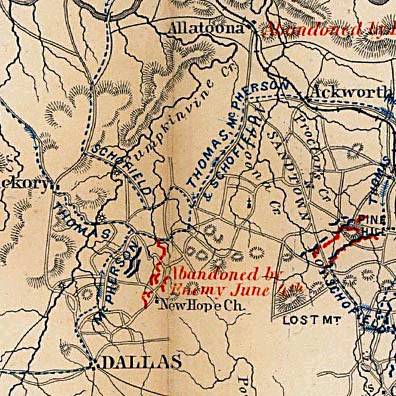 Once
safely across the Etowah River, Johnston moved into an almost
impregnable position in Allatoona Pass. Sherman realized that he could
never hope to successfully carry such a strong position, so he made
plans for a wide flanking movement to the west and south toward Dallas.
On May 23, 1864 Sherman's army began crossing the Etowah at several
points. McPherson swept far to the west and approached Dallas on May
24th and captured that town on the afternoon of the 25th, but was
blocked just east of town when he encountered elements of Hardee's
corps. Johnston's cavalry had detected Sherman's movement almost as soon
as it had begun and Johnston had immediately sent one of his corps to
Dallas, to block the Federals. The next day Johnston pulled the
remainder of his army out of Allatoona and sent Hood and Polk to follow
Hardee. Thomas and Schofield moved directly south from Kingston,
reaching the small crossroads of New Hope Church on the afternoon of the
25th. Hood had arrived just a few hours earlier and his men had hastily
taken positions along the ridge and in the cemetery from which they
quickly beat back Hooker's tentative, initial probing and then began to
entrench. Sherman could not believe Johnston had moved so quickly.
Thinking that he was facing only tenacious cavalry, he ordered Hooker to
make a determined assault. What followed was a bloodbath, in which the
Federals made three unsuccessful and costly attacks on Hood's
entrenchments. Hooker lost 1,800 men without effecting much impact on
Hood. Since continued attacks at New Hope Church appeared to be
pointless, Sherman sought to elongate his lines to try to flank the
Confederate right. Schofield's infantry was dispatched to attack the
Confederates near Pickett's Mill, southeast of New Hope Church. However,
Johnston again anticipated Sherman's intentions, and Cleburne's division
with 1,000 dismounted cavalry were in position to receive the attack.
Schofield's men swept into a ravine and up the further slope to attack
Cleburne's men, who had not yet had an opportunity to entrench.
Fortifications were not needed, however, as the Confederate troops were
able to catch their attackers in a crossfire and subsequently routed
Schofield's troops in a counterattack. Federal losses were substantial,
making Pickett's Mill one of the costliest battles of the campaign.
Throughout the next ten days, Sherman and Johnston probed and parried,
fighting small battles all along the Dallas line as Sherman sought to
outflank Johnston to the northeast and Johnston extended his lines and
counterattacked Sherman's right flank to prevent it. Schofield finally
managed to capture the Dallas-Acworth road on the Confederate extreme
right and Johnston fell back to a new line of entrenchments near Brushy
Mountain and Pine Mountain. Once
safely across the Etowah River, Johnston moved into an almost
impregnable position in Allatoona Pass. Sherman realized that he could
never hope to successfully carry such a strong position, so he made
plans for a wide flanking movement to the west and south toward Dallas.
On May 23, 1864 Sherman's army began crossing the Etowah at several
points. McPherson swept far to the west and approached Dallas on May
24th and captured that town on the afternoon of the 25th, but was
blocked just east of town when he encountered elements of Hardee's
corps. Johnston's cavalry had detected Sherman's movement almost as soon
as it had begun and Johnston had immediately sent one of his corps to
Dallas, to block the Federals. The next day Johnston pulled the
remainder of his army out of Allatoona and sent Hood and Polk to follow
Hardee. Thomas and Schofield moved directly south from Kingston,
reaching the small crossroads of New Hope Church on the afternoon of the
25th. Hood had arrived just a few hours earlier and his men had hastily
taken positions along the ridge and in the cemetery from which they
quickly beat back Hooker's tentative, initial probing and then began to
entrench. Sherman could not believe Johnston had moved so quickly.
Thinking that he was facing only tenacious cavalry, he ordered Hooker to
make a determined assault. What followed was a bloodbath, in which the
Federals made three unsuccessful and costly attacks on Hood's
entrenchments. Hooker lost 1,800 men without effecting much impact on
Hood. Since continued attacks at New Hope Church appeared to be
pointless, Sherman sought to elongate his lines to try to flank the
Confederate right. Schofield's infantry was dispatched to attack the
Confederates near Pickett's Mill, southeast of New Hope Church. However,
Johnston again anticipated Sherman's intentions, and Cleburne's division
with 1,000 dismounted cavalry were in position to receive the attack.
Schofield's men swept into a ravine and up the further slope to attack
Cleburne's men, who had not yet had an opportunity to entrench.
Fortifications were not needed, however, as the Confederate troops were
able to catch their attackers in a crossfire and subsequently routed
Schofield's troops in a counterattack. Federal losses were substantial,
making Pickett's Mill one of the costliest battles of the campaign.
Throughout the next ten days, Sherman and Johnston probed and parried,
fighting small battles all along the Dallas line as Sherman sought to
outflank Johnston to the northeast and Johnston extended his lines and
counterattacked Sherman's right flank to prevent it. Schofield finally
managed to capture the Dallas-Acworth road on the Confederate extreme
right and Johnston fell back to a new line of entrenchments near Brushy
Mountain and Pine Mountain. |

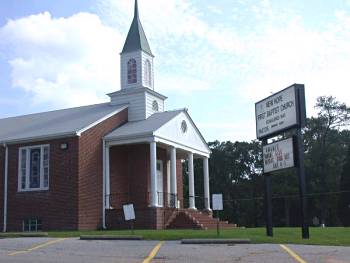
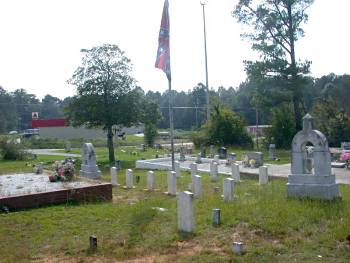

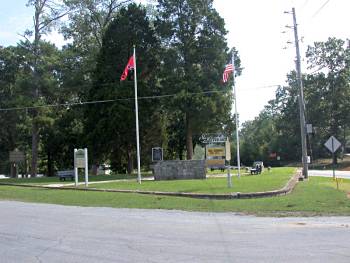
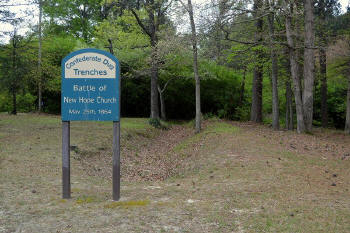
 Once
safely across the Etowah River, Johnston moved into an almost
impregnable position in Allatoona Pass. Sherman realized that he could
never hope to successfully carry such a strong position, so he made
plans for a wide flanking movement to the west and south toward Dallas.
On May 23, 1864 Sherman's army began crossing the Etowah at several
points. McPherson swept far to the west and approached Dallas on May
24th and captured that town on the afternoon of the 25th, but was
blocked just east of town when he encountered elements of Hardee's
corps. Johnston's cavalry had detected Sherman's movement almost as soon
as it had begun and Johnston had immediately sent one of his corps to
Dallas, to block the Federals. The next day Johnston pulled the
remainder of his army out of Allatoona and sent Hood and Polk to follow
Hardee. Thomas and Schofield moved directly south from Kingston,
reaching the small crossroads of New Hope Church on the afternoon of the
25th. Hood had arrived just a few hours earlier and his men had hastily
taken positions along the ridge and in the cemetery from which they
quickly beat back Hooker's tentative, initial probing and then began to
entrench. Sherman could not believe Johnston had moved so quickly.
Thinking that he was facing only tenacious cavalry, he ordered Hooker to
make a determined assault. What followed was a bloodbath, in which the
Federals made three unsuccessful and costly attacks on Hood's
entrenchments. Hooker lost 1,800 men without effecting much impact on
Hood. Since continued attacks at New Hope Church appeared to be
pointless, Sherman sought to elongate his lines to try to flank the
Confederate right. Schofield's infantry was dispatched to attack the
Confederates near Pickett's Mill, southeast of New Hope Church. However,
Johnston again anticipated Sherman's intentions, and Cleburne's division
with 1,000 dismounted cavalry were in position to receive the attack.
Schofield's men swept into a ravine and up the further slope to attack
Cleburne's men, who had not yet had an opportunity to entrench.
Fortifications were not needed, however, as the Confederate troops were
able to catch their attackers in a crossfire and subsequently routed
Schofield's troops in a counterattack. Federal losses were substantial,
making Pickett's Mill one of the costliest battles of the campaign.
Throughout the next ten days, Sherman and Johnston probed and parried,
fighting small battles all along the Dallas line as Sherman sought to
outflank Johnston to the northeast and Johnston extended his lines and
counterattacked Sherman's right flank to prevent it. Schofield finally
managed to capture the Dallas-Acworth road on the Confederate extreme
right and Johnston fell back to a new line of entrenchments near Brushy
Mountain and Pine Mountain.
Once
safely across the Etowah River, Johnston moved into an almost
impregnable position in Allatoona Pass. Sherman realized that he could
never hope to successfully carry such a strong position, so he made
plans for a wide flanking movement to the west and south toward Dallas.
On May 23, 1864 Sherman's army began crossing the Etowah at several
points. McPherson swept far to the west and approached Dallas on May
24th and captured that town on the afternoon of the 25th, but was
blocked just east of town when he encountered elements of Hardee's
corps. Johnston's cavalry had detected Sherman's movement almost as soon
as it had begun and Johnston had immediately sent one of his corps to
Dallas, to block the Federals. The next day Johnston pulled the
remainder of his army out of Allatoona and sent Hood and Polk to follow
Hardee. Thomas and Schofield moved directly south from Kingston,
reaching the small crossroads of New Hope Church on the afternoon of the
25th. Hood had arrived just a few hours earlier and his men had hastily
taken positions along the ridge and in the cemetery from which they
quickly beat back Hooker's tentative, initial probing and then began to
entrench. Sherman could not believe Johnston had moved so quickly.
Thinking that he was facing only tenacious cavalry, he ordered Hooker to
make a determined assault. What followed was a bloodbath, in which the
Federals made three unsuccessful and costly attacks on Hood's
entrenchments. Hooker lost 1,800 men without effecting much impact on
Hood. Since continued attacks at New Hope Church appeared to be
pointless, Sherman sought to elongate his lines to try to flank the
Confederate right. Schofield's infantry was dispatched to attack the
Confederates near Pickett's Mill, southeast of New Hope Church. However,
Johnston again anticipated Sherman's intentions, and Cleburne's division
with 1,000 dismounted cavalry were in position to receive the attack.
Schofield's men swept into a ravine and up the further slope to attack
Cleburne's men, who had not yet had an opportunity to entrench.
Fortifications were not needed, however, as the Confederate troops were
able to catch their attackers in a crossfire and subsequently routed
Schofield's troops in a counterattack. Federal losses were substantial,
making Pickett's Mill one of the costliest battles of the campaign.
Throughout the next ten days, Sherman and Johnston probed and parried,
fighting small battles all along the Dallas line as Sherman sought to
outflank Johnston to the northeast and Johnston extended his lines and
counterattacked Sherman's right flank to prevent it. Schofield finally
managed to capture the Dallas-Acworth road on the Confederate extreme
right and Johnston fell back to a new line of entrenchments near Brushy
Mountain and Pine Mountain.